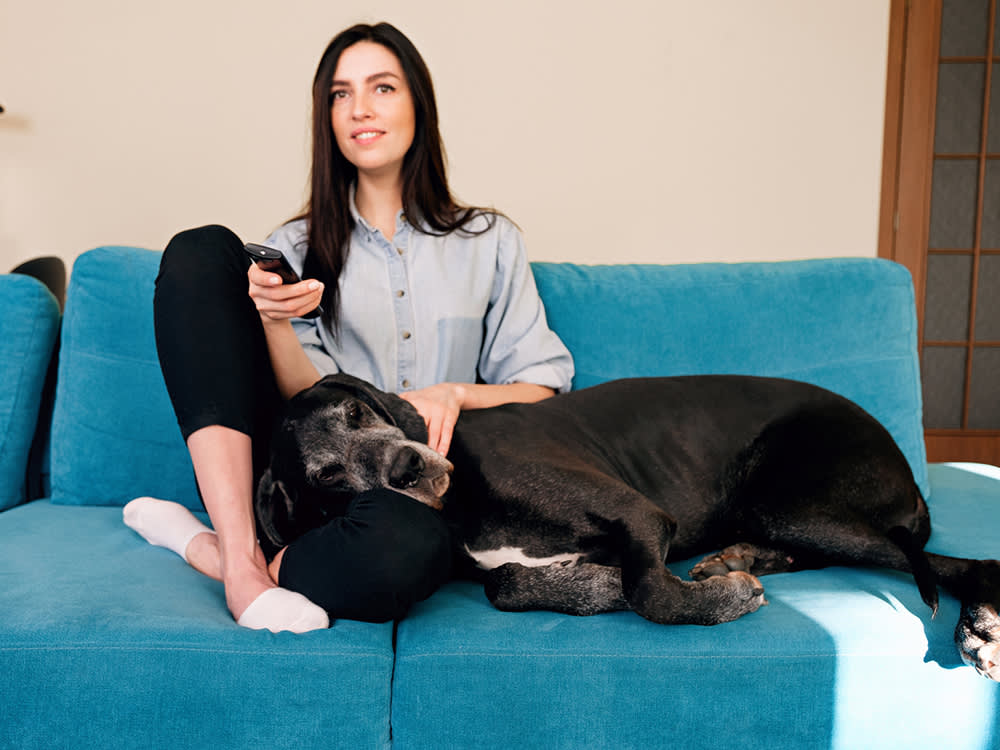What Dogs See When They Watch TV
Is Animal Planet really their favorite channel?

Share Article
In This Article:
Why Do Some Dogs Watch TV and Others Don’t? Why Do Some Dogs Watch TV? What Do Dogs Like To Watch On TV? What Do Dogs See When They Watch TV? Why Does My Dog Attack the TV? Do TVs Comfort Dogs Who Are Left Alone? Frequently Asked Questions
If you haven’t already left an episode of Ted Lasso on for your pup while you’re running errands, you’ve at least wondered: “Would this show keep my dog company?” And you’re not alone: According to a Roveropens in new tab study, two-thirds of pet parents leave the TV on while they are away during the day, 60 percent say their dogs have a favorite show, and and 80 percent report that their dog reacts to what’s happening on the screen. But do dogs really enjoy watching TV?
Camille Ward, a certified applied animal behaviorist, PhD, and founder of behavior consulting company About Dogs LLCopens in new tab, says the answer is complicated.
“We know that they can recognize images on the screen, but to say whether or not they enjoy television, I don’t really know, personally, of any dogs that sit there and watch TV,” she says. “It’s not like we can put dogs in front of the TV and it can occupy them like it would a person or a child.”
Rather than paying attention to a show or movie for long periods of time, dogs tend to glimpse at TVs in short burstsopens in new tab when something familiar catches their attention, such as another dog on the screen, a ball being thrown, or a doorbell ringing.

Why do some dogs watch TV and others don’t?
Television-watching behaviors definitely vary by the pup. Your dog might be like my mom’s Golden Retriever, Annie, who dozes on the couch all day without paying the TV any mind. Or, they might be more like my brother-in-law’s Australian Shepherd, Twyla, who will stand up with her head on a swivel anytime a dog is on the screen. Or maybe they’re somewhere in the middle, like my corgi, Charlotte, who doesn’t care about images on the screen but loses her mind every time a doorbell goes off in a commercial (I have a bone to pick with UberEats and Home Depot).
It is completely normal for some dogs to watch TV and not others. There does not appear to be evidence that TV-watching is associated with intelligence. Instead, research suggestsopens in new tab that TV-watching behavior is associated with age, vision, and breed. Younger dogs with good vision tend to watch TV more than older dogs with deteriorating vision. Sporting and herding breeds also tend to watch TV more than others.
Why do some dogs watch TV?
A dog may watch TV for a number of reasons. Usually, a specific sound or action on the screen will catch their attention, then they’ll watch for a few seconds or minutes. Likely, a dog’s interest in TV comes down to their personality or breed traits. For example, some breeds may also be attracted to certain actions. Terriers, who were bred to hunt vermin, may enjoy squeaky noises on the TV. A herding dog, like Twyla, might be more stimulated by other animals moving on the screen.
What do dogs like to watch on TV?
Anyone whose dog watches TV likely knows that their favorite subjects are — surprise, surprise — other animals. A recent study opens in new tab based on survey responses from more than 1,246 pet parents backs up this theory. Almost 90 percent of respondents said their dogs were most interested in “animal” content, especially dogs. Other topics that caught their attention included “ball sports,” vehicles, non-ball sports, and animation.
The colors that dogs can see may also impact their preferences. For example, my friend’s Bernadoodle, Craig, has a thing for Monster’s Inc., specifically Sully. Theoretically, this makes sense, since blue is one of the main colors that dogs can see, and they like to watch other animals.
What do dogs see when they watch TV?
Dogs see the world differently than we do. In a dog’s eye, there are two types of cones versus three in humans, which gives them dichromatic vision. The result is that dogs do not differentiate between as many colors as (most) humans and experience the world in shades of blue, yellow, gray, and brown. In addition to that, dogs function in low light conditions better than humans.
Next up is the flicker factor. On average, humans don’t see the flickering of a television when the speed is above 55 Hertz. But for dogs who have better motion perception, they’ve been tested on rates up to 75 Hertz. For example, if a television is being displayed at 60Hz, humans would see this as a fluid motion, but dogs would see a set of rapidly flickering images.
Nowadays, televisions and other screens have high-resolution pictures and clear audio, which offer our pups a clear view into another world. Modern HD/4K TVs are refreshed at a much higher rate than older TVs, allowing dogs to view fluid motion. These advances in technology may have contributed to an increase in dogs who watch TV.
“Years ago, it doesn’t seem that dogs were that motivated by TV because we didn’t have screens like we have today where the flicker rates are really high,” Ward says. “Now if they look at it, they’ll actually see movement, they’ll see motion.”
Why does my dog attack the TV?
The improved resolution of TV screens may have an unwanted side effect: an increase in dogs who attack their TVs. “I think it’s more of a problem today that dogs are reacting to TVs because they see it, where years ago, it was a lot of flickering and they weren’t as tuned in to it,” Ward says.
When working with clients whose dogs are reactive to TVs, Ward typically recommends a desensitization process, during which the dog is gradually exposed to triggers on the TV, such as an Animal Planet show, at a distance and at a low volume. When they don’t react and remain calm, they are rewarded with treats and praise. Then the pet parents can gradually increase the exposure by raising the volume and bringing the dog closer to the TV, continuing to reward positive behavior.
“With any problem behavior, the more they rehearse it, the more they practice it, the more it stays in their repertoire and it becomes stronger over time,” Ward says. “So we want to prevent it, and teach them an alternative response and change how they feel about that trigger, which might be animals on TV.”
Do TVs comfort dogs who are left alone?
Many pet parents leave a TV on to keep their dogs company when they are going out. So, is there any proof that this actually provides comfort? There doesn’t appear to be any major research on the topic; it likely depends on the dog and their personality.
For example, if a dog is used to a rowdy household with a lot of noise and excitement, the sounds of a TV may be more comfortable or “normal” for the dog when left alone, compared to the silence of an empty house. On the other hand, if a dog is skittish, sensitive to noise, or tends to prefer peace and quiet, leaving a TV on likely isn’t doing them any favors.
Ward cautions that turning on the TV can actually become a pre-departure cue, or a signal to your dog that you’re about to leave, similar to picking up your keys or putting on a coat. If turning on the TV becomes part of your exit routine, dogs may begin to associate it with you leaving. For dogs with separation anxiety, this can add to their stress, rather than alleviate it.
That being said, you know your pup best. If you’ve been leaving the TV on for them for years and it appears to be soothing, keep doing what you’re doing.
FAQs
Do intelligent dogs watch TV?
There is no evidence that TV-watching is associated with canine intelligence. A dog’s tendency to watch TV is more likely related to their age, breed, and personality.
What colors do dogs see?
Dogs’ vision is dichromatic, and they experience the world in shades of blue, yellow, brown, and gray.
References
Byosiere, Sarah-Elizabeth, et al. “What Do Dogs (Canis Familiaris) See? A Review of Vision in Dogs and Implications for Cognition Research.” Psychonomic Bulletin & Review, vol. 25, no. 5, 15 Nov. 2017, pp. 1798–1813, link.springer.com/article/10.3758/s13423-017-1404-7opens in new tab, https://doi.org/10.3758/s13423-017-1404-7opens in new tab.
“Do Dogs Understand What They Are Seeing on Television?” Psychology Today, 2024, www.psychologytoday.com/us/blog/canine-corner/201106/do-dogs-understand-what-they-are-seeing-on-televisionopens in new tab. Accessed 17 Dec. 2024.
Donohue, LK, et al. “Screen Interaction Behavior in Companion Dogs: Results from a Dog Owner Survey.” Applied Animal Behaviour Science, vol. 270, 1 Jan. 2024, pp. 106151–106151, https://doi.org/10.1016/j.applanim.2023.106151opens in new tab. Accessed 29 Jan. 2024.
Langley, Liz. “Why Do Dogs Watch—and React To—TV?” Animals, 11 Jan. 2015, www.nationalgeographic.com/animals/article/150111-animals-dogs-television-pets-science-tv-behavioropens in new tab. Accessed 17 Dec. 2024.
Staff, AKC. “Why Does My Dog Watch TV?” American Kennel Club, 17 Jan. 2022, www.akc.org/expert-advice/lifestyle/why-does-my-dog-watch-tv/opens in new tab. Accessed 17 Dec. 2024.

Daniela Lopez
Daniela Lopez is a digital media specialist and long-time contributor to The Bark.

Missy Schrott Boylan
Missy Schrott Boylan is a writer specializing in pets, child welfare, and community journalism. Her pets writing has been featured in People, The Spruce Pets, and The Canine Review. Missy also enjoys photography, with her star subject being her five-year-old Corgi, Charlotte.
Related articles
Are Dogs Color Blind? How Do We Know What Colors Dogs Can See?
It’s not all black and white.
![close up of Chihuahua dog's eye with cataracts]()
Common Eye Problems in Dogs and How to Treat Them
Your dog sees you as their best friend, so keep those eyes healthy.
![Dog in the sand smiling at the camera]()
Can Dogs Smile?
There’s a big difference between a dog smiling and showing their teeth.
![Black cat sitting on top of a leather sofa staring up at an abstract painting in a modern living room]()
Creative Interiors and the Cats Who Call Them Home
Talking to Vogue Living photographer Paul Barbera about his new feline-focused interior design book, Where They Purr.
![close up of Chihuahua dog's eye with cataracts]()
Common Eye Problems in Dogs and How to Treat Them
Your dog sees you as their best friend, so keep those eyes healthy.
Can Dogs See in the Dark? Does My Dog Have Night Vision?
Hopefully, they at least fare better than we do when the lights go out.







